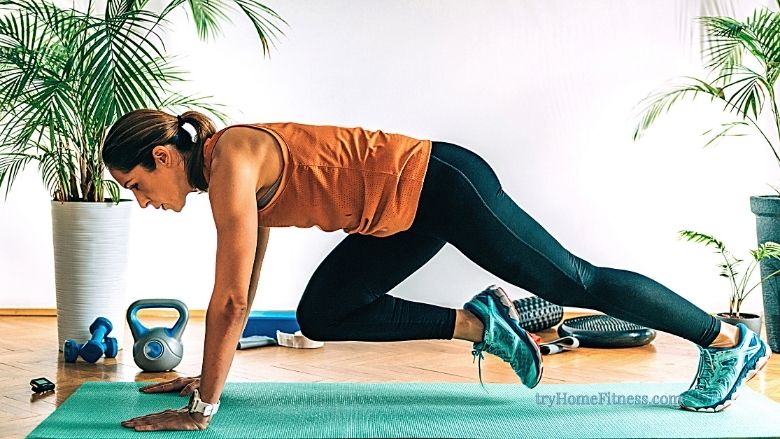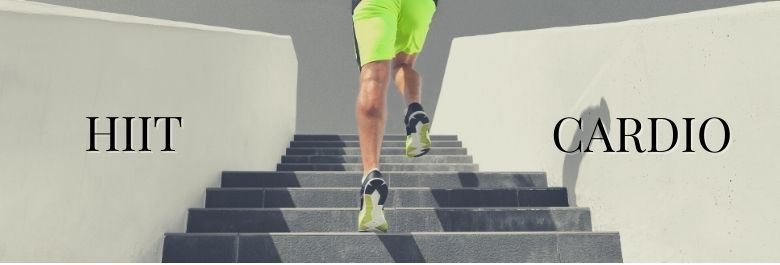Everyone says that physical activity is great for you. Although what’s it to be? HIIT vs cardio, aerobic vs anaerobic, gym or home, running or walking. You can hear lots of conflicting ideas about the best workout, but they all say you need it. Are they right? Do you care?
Well, if you’re a nihilist, then nothing matters anyway. But exercising has a wide array of benefits. Think better weight management, slower aging, reduced risk of numerous diseases, better cardiovascular health, reduced anxiety or depression, and better sleep.
On top of that, you’ll be stronger and look better.
So, it’s beyond any doubt that physical activity improves, at least in some way, every aspect of your health. You just need to find the best exercise habits to suit your lifestyle and schedule.
So let’s look at hard and fast vs long and slow, HIIT vs Cardio.
Contents
The Rise of HIIT Workout
HIIT (high-intensity interval training) has become very popular for good reasons. It is a highly effective workout regime that delivers results quickly. Basically, it’s interval training that alternates short periods of near maximum intensity exercise with low-intensity recovery periods. As a consequence, you reap the benefits while devoting less time compared to traditional workout forms.
It looks like it’s been designed to meet the needs of modern humans hurrying through the day to get everything done.
Nevertheless, HIIT is not a condensed, second-best alternative to traditional forms of training. It’s genuine and efficient training with both aerobic and anaerobic benefits. More on that, later on.
Steady-State Cardio
Some people call it LISS (low-intensity steady state) training. Anyhow, it’s a traditional form of aerobic exercise. Brisk-walking, running, swimming, and cycling, are typical steady-state cardio, as long as you keep the intensity low to moderate. Ellipticals, treadmills, rowers, and steppers provide the same kind of training, indoors.
But it’s always more enjoyable to get outside in the countryside for a steady, long jaunt.



However, variable methods have been included with even-paced training to shake things up, for a long time.
There was the great Fin Paavo Nurmi who in 1916 at the age of 19, optimized his training program to include walking, sprints and strength training.
Again, from the Nordic region, what runner could overlook a method of training “invented” in 1930 called fartlek? Put simply it means short periods of fast running mixed in with steadier speed.
I know when I was training for a marathon or other specific long distance events I would go by a weekly rota of workouts which would include speed work, intervals, long runs to include Fartlek and hill work. Oh and a couple of weekly strength training sessions thrown in.
It’s been a cornerstone in training programs for as long as I can remember. Decades of training at whatever intensity guarantees that this training delivers all sorts of benefits. From making your heart more efficient to endurance and fat loss.
Major Differences Between HIIT vs Cardio
Imagine you’re climbing a mountain. You can choose the shortest, almost direct route, or you can find a way around to avoid steeper sections of the climb. Whichever you choose, you’ll get to the top. The former path will be more demanding and tiring, so you’ll probably take a few breaks to catch your breath. The latter will allow you to keep a slow and steady pace until you reach the summit.
So, which strategy is more effective? No straight answer here. It depends on your personal preferences, how fit you are, if you have a time limit to reach the summit before heading back, and so on.
It’s the same with HIIT and LISS training. Both types of workout will help you achieve desired goals but they use different strategies to get you there.
The greatest distinction between HIIT and steady-state cardio is the intensity and duration. Like quick ascent, HIIT will push you nearly to the maximum with consecutive high-intensity and recovery periods.
Steady-state cardio is like choosing the easier path on the mountain. It allows you to maintain consistent speed and moderate or low intensity. However, you’ll need to workout longer to get the best out of it.
Typical HIIT Workout
You can apply HIIT training to any type of exercise – from running, biking, jumping rope, to burpees, squat jumps, and other body-weight exercises.
Spin bikes have become a popular way of combining home fitness cardio with HIIT interactive sessions using streaming video coaches to provide the motivation to hit short maximum bursts of output.
CAR.O.L has gone one step further in designing their AI-driven bike to dynamically monitor and push the fitness boundaries. They believe that 8 minutes, 3 times a week is all you need and compares with a full program of Cardio and strength training. A revolutionary idea. Well, there is research to back it up. We will be putting it to the test so watch this space.
Other suitable cardio equipment that can extend and provide excellent high intensity workouts are vertical climbers, elliptical machines and treadmills.
So, HIIT is not about what you do but how you do it.
This is one I do regularly that involves no equipment but it is pretty fast and furious.
A typical HIIT session should last from 15 to 30 minutes, including warm-up and cooling down. If you choose running, for example, you should sprint hard for let’s say 60 seconds, then jog for 30 seconds and that’s one HIIT cycle. Repeat this, 5-6 times, cool down for around 5 minutes and your HIIT session is over.
Your power output during the high-intensity section should be maxed out. There is something to be said for having a fairly solid platform of fitness first.
It’s the same principle if you choose other exercises. You just have to make it hard so that your heart rate rises to 80-95% of your maximum heart rate during the high-intensity bouts.
You can adjust the interval to match your current fitness level. High-intensity bursts shouldn’t last more than two minutes and the work-to-rest ratio can vary from 1:2 to 2:1. Some experts recommend starting with a 1-1-5 (high-intensity / low-intensity / rest) formula for beginners.
Benefits of HIIT
- HIIT can be responsible for a big calorie burn.
- You’ll burn calories for hours after the workout. HIIT continues to burn calories as the body tries to get itself back to normal long after you’re done exercising.
- The intensity will build your muscles. Many HIIT programs involve several different exercises that activate different muscle groups.
- It improves your aerobic capacity. VO2, or maximum oxygen intake, increases a lot if you do HIIT programs on a regular basis. It’s a bit counterintuitive as HIIT is predominantly anaerobic exercise, but it outmatches steady-state cardio in this department.
- It strengthens the heart and lowers high blood pressure. HIIT is great for cardiovascular health overall. While it lowers heart rate and blood pressure in overweight individuals with high blood pressure, it doesn’t affect normal blood pressure.
- It’s not time-consuming. Short sessions are a godsend for those who have busy schedules.
- Effective in controlling blood sugar. Any cardio training increases the metabolism of glucose. HIIT training appears to provide results faster than other exercise methods.
- Versatility. While you have to stick to alternating between short bursts and recovery periods, it’s completely up to you to choose exercise type. You can also mix different exercises and include more muscle groups.
Typical Low-Intensity Cardio
Steady-state training is as simple as it gets. Whether you brisk-walk, run, swim, or ride a bike, you just need to keep a steady pace. It’s about steady, moderate effort for an extended period of time. It should be challenging, but sustainable.
For an elite runner the mantra was often and long meaning the more miles you ran per week the better would be endurance and stamina.
The most I ran in a week was 80 miles and it was a one-off. It sounds obvious but the more miles you put in the more important it is for the body to recover. For me, it wasn’t sustainable.
And for the record, the most I ever ran in a day was 35 miles. Not huge, I admit. Furthermore, I ran 15 miles first in Sydney (Australia) then traveled over the International Dateline and did another 20 in LA. Cheat!
The “talk-sing test” is a great way to determine the intensity. If you can’t talk during the workout, you’re working too hard and you won’t last long. If you can sing, you aren’t working hard enough! So, the correct intensity is when you can talk but not sing during your training.



Benefits of Steady-State Workouts
- It improves your fitness level, especially endurance.
- It’s the most popular form of training to improve aerobic capacity as well as cardiovascular fitness. It is a tried and tested method.
- You can recover quickly. Low intensity means less stress on your muscles as well as your cardiorespiratory system.
- Lower intensity is related to decreased risk of injury. Simply, the mechanical stress is far lower compared to high-intensity forms of training. However, be careful. Too long, or too frequent sessions increase the risk of injury because you repeat the same movement over and over again.
- It’s beginner-friendly. Don’t worry about your current fitness level. While HIIT requires almost maximum effort to reap the benefits, steady-state cardio allows you to get started slowly, and increase the load gradually.
Head-to-Head Comparison
Obviously, both forms of activity are great for your fitness and health and they share some similar benefits. Let’s dig deeper to see how they compare.
Metabolic Effects
Both HIIT and traditional cardio improve metabolism, increase VO2 (maximal aerobic capacity), help with high blood pressure, blood sugar control, and fat loss.
Surprisingly, HIIT improves VO2 faster.
Both methods are great for blood pressure control.
Both HIIT and steady-state cardio improve insulin sensitivity (which is good), but HIIT is slightly more efficient.
As for fat loss, it depends on the type and duration of activity. HIIT burns more calories per minute, but you can burn as much with traditional cardio. HIIT training also changes your EPOC (excess post-exercise oxygen consumption). It means that your body continues to burn more calories for a couple of hours after the workout. And that’s not all: HIIT is more efficient at burning visceral fat (internal fat around organs).
So, overall, both methods do a lot of good for your metabolism but HIIT is slightly more efficient.
Weight Management
Don’t believe that any exercise is enough to lose weight. A balanced diet and any kind of training will do the trick, though.
Anyway, both methods are great for weight management, but HIIT wins the race because of the aforementioned metabolic effects.
Endurance and Stamina
Nothing beats good old long-distance running to improve endurance and stamina. Or that’s what we thought for years. Even though HIIT training is more anaerobic than aerobic, done regularly 3 times a week, it significantly improves endurance and stamina.
Opinions differ which method is marginally superior. For me, I still think both is a win-win.
Muscle Health
This is where HIIT and traditional cardio diverge a lot.
HIIT training may be too challenging for beginners. It puts a lot of both mechanical and metabolic stress on your muscles. As a result, there’s a higher risk of strains and injuries.



On the upside, if you avoid injuries, your muscles will grow stronger quickly.
Traditional cardio is not that stressful and it will enhance your muscle strength and endurance. Still, make sure not to overuse them. Repetitive stress can also increase the risk of injuries.
What About Different Age Groups?
Youngsters and adults can reap the benefits of both regimes to their liking.
HIIT appears to be very demanding albeit for small bouts of time, so is it risky for the older population?
Yes and no. The truth is that as we age we need to workout more, not less. There’s no reason to avoid HIIT for healthy and injury-free senior citizens. However, if there are some health conditions and issues it might be better to stick with moderate intensity activities.
And as mentioned before don’t take my views to be medical advice. Always speak with your medical practitioner if you have any doubts or are planning to suddenly change your physical activity levels
How to Balance a Weekly Workout Schedule
Any type of exercise will contribute to better health, but none of them will cover all your needs. In a perfect world, you should mix low-intensity and high-intensity sessions to get the most out of your workouts. And don’t forget strength training. It comes with its own set of benefits.
However, all guides on traditional cardio recommend 3 to 5 sessions a week, strength guides aim for 2 to 4 sessions, and HIIT training should be done 2 or 3 times a week. Sum it up and you get at least 7 days, up to 12 days a week!
Recovery is paramount if you want to keep your muscles healthy, so you need to rest at least one day a week.
However, there are a couple of ways out of this conundrum. First, if you’re not very fit, HIIT should be done moderately or leave it out altogether. Well, at least until you build some strength and fitness.
Another way is to focus on one type of training and complement it with less frequent sessions of the other two types. For example, a 2-2-1 formula with the focus on HIIT training( 2 days of HIIT, 2 days of jogging or brisk-walking, and one day of strength training a week).
If you’re already very fit, you can combine HIIT and strength training. For example, add weights and perform squat jumps, box jumps, jumping lungs, or other plyometric exercises that make a great HIIT training.
While combining different types of workouts provides enhanced benefits, it’s essential not to overdo it. Make sure you have enough time to recover between two training sessions. Avoid high-intensity, consecutive sessions and aim to target different muscle groups.
Finally, be smart. Assess your own fitness level objectively to make the most effective weekly plan.
Final Verdict
If you read the whole article, you don’t need the final call. You already know that you can’t choose HIIT vs Cardio. Both hard and fast or long and slow methods can and will improve your fitness and health.
According to tons of research HIIT can produce as much if not more beneficial results than normal cardio. But as we’ve said traditional low and slow cardio has, for many years, been considered most effective when combined with speed and strength work.
The big advantage with high-intensity workouts is that they are short and they can be very short. But for maximum gain, the amount of intensity for that short period of time shouldn’t be underestimated.
Along with strength training and steady long cardio, incorporating a HIIT program 2 or 3 times a week at a suitable level of intensity into your training diary will give exercise enthusiasts a time-efficient way of reaching their goals.
And because results should be seen quickly motivation will remain high. The best and the most effective workout is the one you’ll keep doing.
So HIIT the road.

